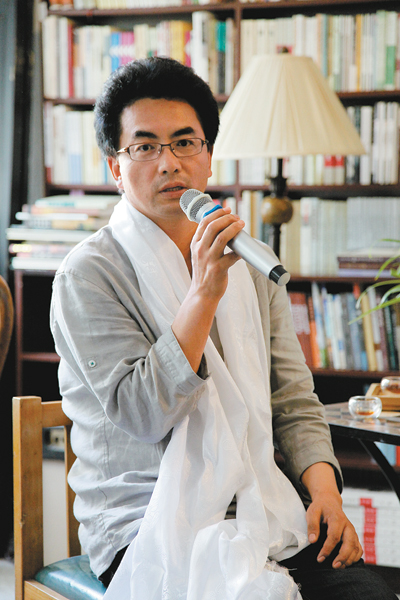
Cao Zhen
caozhen0806@126.com
SINCE most people who have never been to Tibet can only learn about the superficial aspects of Tibetan culture through the plateau’s stunning landscape and mysterious traditions, author and movie director Pema Tseden aims to present the real and modern Tibet to outsiders.
Pema Tseden, who is renowned for his magical realism writing style, has published his new book “The Silent Holy Stones” in Mandarin. The 220-page book contains 10 short stories written from a non-judgmental angle to portray contemporary Tibetan life.
Some stories in the book draw from indigenous traditions about the supernatural and its hovering presence beneath the surface of the every day. In “The Silent Holy Stones,” the first story in the book, a dead stone-carver always comes back to the village at night to finish his Mani-stone-carving, sometimes appearing in villagers’ dreams. Mani stones are plates or rocks inscribed with the six-syllable mantra of Avalokiteshvara, a form of prayer in Tibetan Buddhism.
Although the story is beyond reality, Pema Tseden uses simple dialogue and smooth narration to authentically depict ordinary Tibetans’ lives and beliefs. He once said he is reluctant to shoot or write about the blue sky and the plateau landscapes in his movies and novels because he wants to display Tibet in his own way. Therefore, in his books and movies, he includes not just the sights, but also the sounds, smells, and feel of modern Tibetans.
Pema Tseden said his magical realism style came from his research into Tibetan history and Latin American literature. “Tibetan history books are written like literature,” he explained in a recent interview in Shenzhen. “It blends many folk tales into historical events. This is a unique feature of Tibetan culture, one that blurs reality and fiction.”
Born in 1969 in the Tibetan region of Amdo in Qinghai Province to nomadic herder parents, Pema Tseden studied Tibetan literature at Northwest University for Nationalities in Lanzhou, Gansu Province. Since 1991, he has published more than 50 novels and short fiction pieces in both Tibetan and Mandarin.
Having a passion for movies, he studied directing at the Beijing Film Academy in the 2000s and shot several documentaries and art house movies on Tibetan life, such as “The Silent Holy Stones” (2005), “The Search” (2009) and “The Old Dog” (2011). His subject is consistent: the contemporary culture and life of Tibet, a practice that consciously puts his films in contrast with the exotic fiction features about Tibet that have been produced by outsiders.
Since making a Tibet-themed movie needs tangled permission from various national departments and some illusory and religious fragments are often censored, Pema Tseden’s movies are more realistic while his novels focus on magical realism.
He said that when he was a child, he loved to listen to folk stories on the radio or from local adults. In the 1980s, he was fascinated by Gabriel Garcia Marquez’s and Mo Yan’s magical realism novels. Pema Tseden is not the first Tibetan author to follow Latin American magical realism. In the 1980s, Tibetan novelist Tashi Dawa shocked the literary scenes with a series of powerful and innovative magical realism short stories written in Mandarin.
Pema Tseden grew up Buddhist, so it’s no surprise that religion permeates his work, but there is something unusual about his humorous tone when he writes about this mystical religion. In the story “Wujin’s Teeth,” he vividly portrays the friendship of two boys and how they maintain their friendship after they grow up and one of them becomes a respected Tulku (an honorary title given to a lama recognized in Tibetan Buddhism as reincarnated). Pema Tseden writes about the Tulku’s happy childhood when he was a naughty boy and his kindness to his longtime friend through simple dialogue. The image of the fictional Tulku is portrayed as true to life and is no longer mysterious to readers.
To create a good story, writers must invent strong characters, throw in obstacles and show how the characters can overcome those obstacles. Pema Tseden succeeds on all counts with “The Ninth Man.” This story stuns readers by depicting a Tibetan woman who has slept with nine men. The lead character seeks her own pleasures, but her needs are not simply sexual — she needs to feel free. The story is attractive because it features a strong Tibetan female character that has depth and courage.
Pema Tseden doesn’t normally provide a typical ending to his stories. He takes a neutral approach to how modern civilization is changing traditional Tibetan life. He once used the phrase “spiritual suicide” to refer to the difficult decisions characters must make in contemporary Tibetan society, so he leaves the ending open to get readers to think.
In an earlier interview, he personally expressed that some outsiders who hope Tibet reserves its agricultural and nomadic lifestyle are selfish because “Tibet needs modern development and Tibetans need to improve their lives.”
Books by Pema Tseden are now available in bookstores and on amazon.cn.
|

